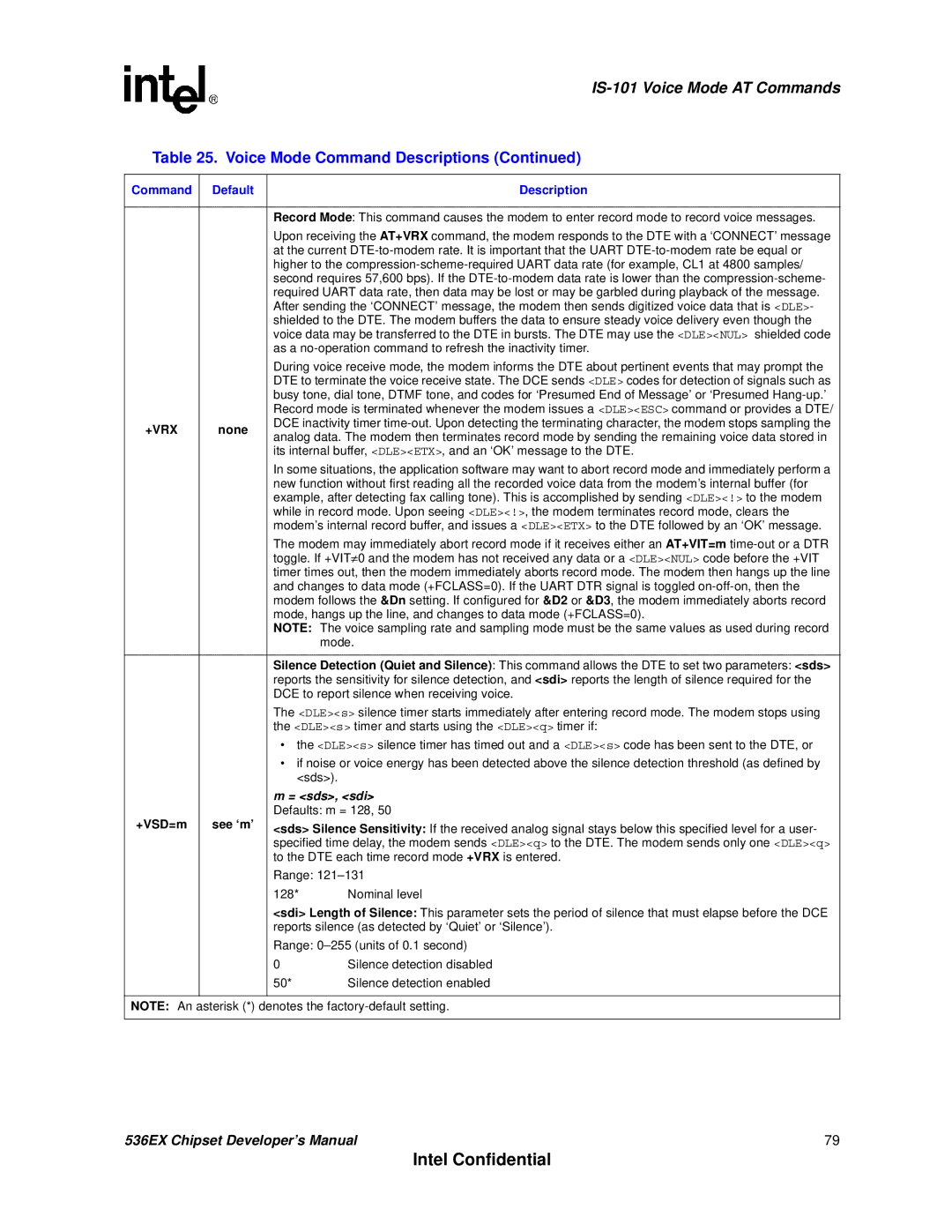Developer’s Manual
537EX Chipset
Intel Confidential
Contents
Figures
Tables
Date Revision Description
Revision History
001 Initial release
Controllerless Modem Driver Overview
Introduction
Windows 95 and Windows
Intelsdb.VXD
V.90/V.92 and V.34 Data Modes
Tapi
Unimodem
Modem Connection Overview
DCE-to-ISP Data Rates for V.90 Mode
AT Commands Overview
DTE-to-DCE Data Rates for Each Mode
DCE-to-DCE Data Rates for Each Mode
Numeric Text
Sending Commands
Delayed Call
DTE-Modem Data Rate Response Codes
Dialing digits
Command Function
AT Escape Sequences
Dial Modifier
Command Function Default Range Reported By &Vn
Data Mode Command Summary
Intel Confidential
Intel Confidential
Intel Confidential
+ETBM
+EB
+ESA
+ESR
44/V.42/V.42 bis MNP Command Summary
Processes flow control characters and passes to local
Fax Class 1 Command Summary
Fax Identity Command Summary
Voice DTE→DCE Character Pairs
IS-101 Voice Command Summary
Response Hex Code Function
ESC
Voice DTE →DCE Character Pairs
Voice DTE←DCE Character Pairs
DEL
Ascii
Register Function Default Range Units Reported by &Vn
Dial Modifiers
Register Summary
Register Function Default Range Units
Modem Responses and Command Echo En, Vn, Xn, Wn, Qn
Using AT Commands to Access the S-Registers Sn?, Sn=x, ?
Modem Setup Host Modem Response Command
Data Reporting Wn Mapping
Disable Enable
DTE
Resets and then configures the modem to Nvram user profile
Establishing a Modem Connection A, D, DS = n, S0
AT Commands Product Information
Product Identification Information
Hanging Up Hn, S10, Zn, &D2
Online Command Mode Escape Codes, On
Modem-to-Modem Connection Data Rates
Intel Confidential
Modem-on-Hold Incoming Voice Call in Data Mode
Modem-on-Hold Initiating a Voice Call in Data Mode
Intel Confidential
Carrier Description
Supported Modulation Types
Local Analog Loopback AT&T1
Diagnostic Testing S18, &Tn
Local Modem or Test Modem
Local Analog Loopback With Self-Test AT&T8
Time-Independent Escape Sequence
AT Escape Sequences
Licensing Requirements for Hayes Escape Sequence
Example
Command Default Description
Data Mode Command Descriptions
Hayes* Escape Sequence
Echo enabled
Previously stored in the Nvram with the AT&Zn=x command
Host in either online or off-line command mode
Echo disabled
DTE
ATI2
Sn=x
Numeric form
Command
Modem dials a telephone number touch tone dialing
Numeric or verbose form
DCD or Rlsd signal
Disconnecting
Subsequent commands to be ignored
Resets the modem and recalls user profile
Telephone Numbers
AT&V0
Active Profile
Stored Profile
= 0-9 a B C D # * T P R W @
S-register configurations into the Nvram user profile ‘n’
Command to see the stored telephone number
Select profile
Indication Definition
Command Default
+EB
12/V.34
CRC generation and checking disabled
Nrzi encoding and decoding disabled
Secondary channel operation, and vice versa
+ETBM
+ESR
+ILRR=m
+GMR
+GSN
+IFC
If +MS = ,0,, no alternative modulations will be available
+MS command description
+MA? will display a list of enabled alternative modulations
= carrier,carrier,…carrier
+MS=m See ‘m’
Carrier Description
BELL103
BELL212
+PMHR
+PHSW=
+PMHF
Value Description
Disable short Phase 1 and Short Phase
Conjunction with the +PSS command
Enable Short Phase 1 and Short Phase
Enable Short Phase
Operating Modes
Mode Features
+ES=1, 0 +ES=4, 4 +ES=3, 0 +ES=3, 2
44/V.42/V.42 bis and MNP Data Modem Command Descriptions
+ES Settings Answer Modem
Resulting +ES Connection Types
\Bn
\Kn
Max string
+DR=m
Direction
+DS=m
+EFCS=m
3768
+ER Lapm
Display messages when +ER =
Decimal value and the format is as follows
+ER=m
+ES=m
Setting is ignored if origrqst=6
Control during non-error control operation
Non-error control operation
+FMFR?/+FMI
Fax Identity Commands
Fax Class 1 Commands
Fax Identity Command Descriptions
Value Modulation Speed bps
Mod Selection Table
Class 1 DTE-Generated Hdlc Frame Information AT+FTH=mod
30 Hdlc Frame Format
+FCLASS?
Fax Mode Command Descriptions
+FCLASS
+FRS=m
+FRH=m
+FTH=m
IS-101 Voice Mode AT Commands
Dtmf Detection Reporting
Voice Mode Command Descriptions
Relay Control
+FLO=m
+VDR=m See ‘m’
Enable report Function
+VEM=m See ‘m’
Defaults = ‘C’, BB860980, BFE63883, BB863EE0
Caller ID report Command Reserved Distinctive ringing All
Event Description
EX Value BIT Value Event
EIGHT-DIGIT HEX Code B B 8 6 3 E E
HEX Digit Location
128 Nominal transmit level
Local telephone, or speaker
+VIP
Label
Preassigned Voice I/O Labels
+VLS=m
Relay/Playback Control
Voice I/O Primitive Codes
Primitive Code Description
+VSD=m See ‘m’
+VRX
Range 4800, 7200, 8000, and 11025 samples/second
+VSM=? command to obtain supported sampling rates
141 AD3 3-bit Adaptive differential pulse code modulation
+VSM=m
Compression
Cml
Serial
Hard Disk
Range 5-255 units of 0.01 seconds
Factory default is ‘0’
100 Default value 1 second
100
This sends a 500 ms period of silence
Dual tones may be sent using the following format
+VTS=m None
Specified by +VTD=m
Command Default Description
Register Command Descriptions
S10
Escape sequences
Range Seconds Default 0 seconds
S16
S30
S21
S22 118
S25
Inactive state when
Modem exits sleep mode whenever the host reads or writes to
Modem or when a ring signal is detected
Sleep mode is disabled by setting S33 to ‘0’
Tag Description
Caller ID Tags for Formatted Reporting
Ring
Uart Emulation in Intelsdb.VxD
Uart Emulation in the Controllerless Modem
THR
Uart
RBR
Parallel Host Interface Uart Register Bit Assignments
Scratch Register SCR
Uart Register Definitions
Modem Status Register MSR
Stack
Bit Framing error
OE Overrun Error-Not supported
Line Status Register LSR
Line Control Register LCR
IER Interrupt Enable register
Procedure is as follows
Modem Control Register MCR
Bit
Fifo Control Register FCR
Interrupt Control Functions
Interrupt Identity Register IIR
ID1 ID0
Dlab =
Interrupt Enable Register IER
ID bit 2 for Fifo mode
Transmitter Holding Register THR
Data Rate Divisor Number Divisor Latch Hex
Receiver Buffer Register RBR
Divisor Latch Registers DLM and DLL
Programmable Data Rates
102
Fifo Interrupt Mode Operation
Fifo Polled Mode Operation
16C550A Uart Fifo Operation
536EX Chipset Developer’s Manual 103

